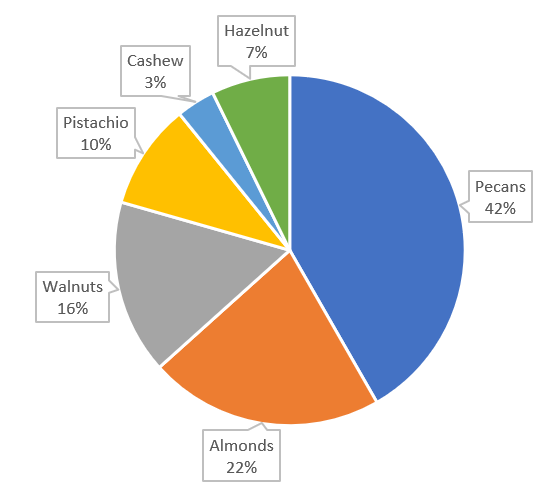
In 2016, after years of dreaming and working to develop a Federal Marketing Order (FMO), our historically divided industry came together and established the American Pecan Council for the common goal of building awareness and demand for American Pecans. In the beginning stages of the FMO, consumer research was conducted and showed pecans lagged tremendously behind other major tree nut commodities that had similar programs in place for decades. The results validated industry’s want and need to unify marketing efforts.
The APC is governed by industry representatives from each growing region, and every five years, growers can vote to continue the FMO, making it one of the purest forms of local government the industry has at its disposal. As you know, our industry just went through its first referendum. The original voting period was extended through July 23 to ensure all growers had a chance to vote. On Sept. 1, USDA published that pecan producers voted to continue their marketing order program applicable to pecans grown in Alabama, Arkansas, Arizona, California, Florida, Georgia, Kansas, Louisiana, Missouri, Mississippi, North Carolina, New Mexico, Oklahoma, South Carolina and Texas. In light of these results and the questions we continue to receive, we put together an “FMO 201” article to address the functions of an FMO, what has been accomplished, and look at what is to come.
FMO Functions
Authorized by the Agricultural Marketing Agreement Act of 1937, marketing orders are industry-driven programs that help producers and handlers achieve marketing success by leveraging their own funds to design and execute programs. Each order and agreement is tailored to the individual industry’s needs. The marketing order authorizes data collection, research, domestic and international promotion activities as well as regulation of grade, size, quality, pack and containers for pecans grown in 15 states under the oversight of USDA. Authorities under the marketing order support the industry’s effort to thrive in a competitive marketplace. As a reminder, below are the tools and functions of a Federal Marketing Order broken down by what the APC can and cannot do.
The APC cannot lobby, buy/sell product, set prices or set tariffs. These activities are not permissible under the FMO and will not be approved by USDA. We still do receive questions on what APC is doing about prices. APC is focused on increasing consumption, which moves supply and creates a vacuum. Prices will hopefully follow along with supply and demand, but we cannot set prices.

First Five
The pecan Federal Marketing Order is still in its infancy stages compared to other similar commodity FMOs. However, industry has made large strides and boasts many accomplishments we can celebrate from just five years of existence. Recall that the industry came together and created the FMO in 2016. The program began hiring staff during 2017-18 gearing up for the work ahead for the industry. A strategic plan was conducted by Boston Consulting Group in 2018-19 to develop a long-term vision and plan of action for the future of the pecan industry. In the 2019-20 year, APC implemented marketing programs, established the monthly pecan industry position reports with handler data and conducted the first round of compliance audits to ensure accuracy of the handler reporting forms. All these activities were guided by the results from extensive research and the strategic plan. During 2020-21, we have continued to build on those programs. In the marketing realm, industry saw big results in the first quarter especially, where pecans became the number one talked-about nut. This was a first in pecan history!
Demand for pecans has accelerated since the start of the FMO, with a 36% growth in consumption. The results from a third-party study required by USDA known as a Fair Act Study showed prices have grown or sustained 11% or 24 cents back to the grower. In other words, according to the study, prices would be 24 cents lower if it wasn’t for the marketing and promotion that the industry is doing through the FMO. We are seeing the first fruits from all the hard work of the industry and setting aside differences to unify marketing efforts. Overall, inventory has been moving, export volumes have grown and pecans have dominated the holidays. We are doing a great job as an industry, and by working together and sticking with the plan, we are seeing the results!
What’s to Come
Now, the big question we get is, “Where are we going from here? What’s next?” There were many industry firsts throughout the first five years of the FMO’s existence. In addition to the accomplishments mentioned above, we have gathered all industry associations together for recurring Pecan Congress meetings, a quality assurance program is currently in the works, and we have developed a crisis communication plan for the industry, so if there is an outbreak or food safety issue, it is the APC’s job to coordinate those messages. APC also audits handlers on data. Prior to the FMO, there were only estimates, but APC has the authority to collect mandated data and audit for accuracy.
We have much more in the pipeline, and with the induction of the American Pecan Promotion Board, we have an excellent opportunity for the two complementary programs to collaborate on understanding global marketing conditions and conducting consumer research in order to expand domestic and international markets. Stay tuned; in the upcoming year, we will be writing articles that provide updates on these programs and the activities being conducted under each of the key areas of focus for the FMO.















